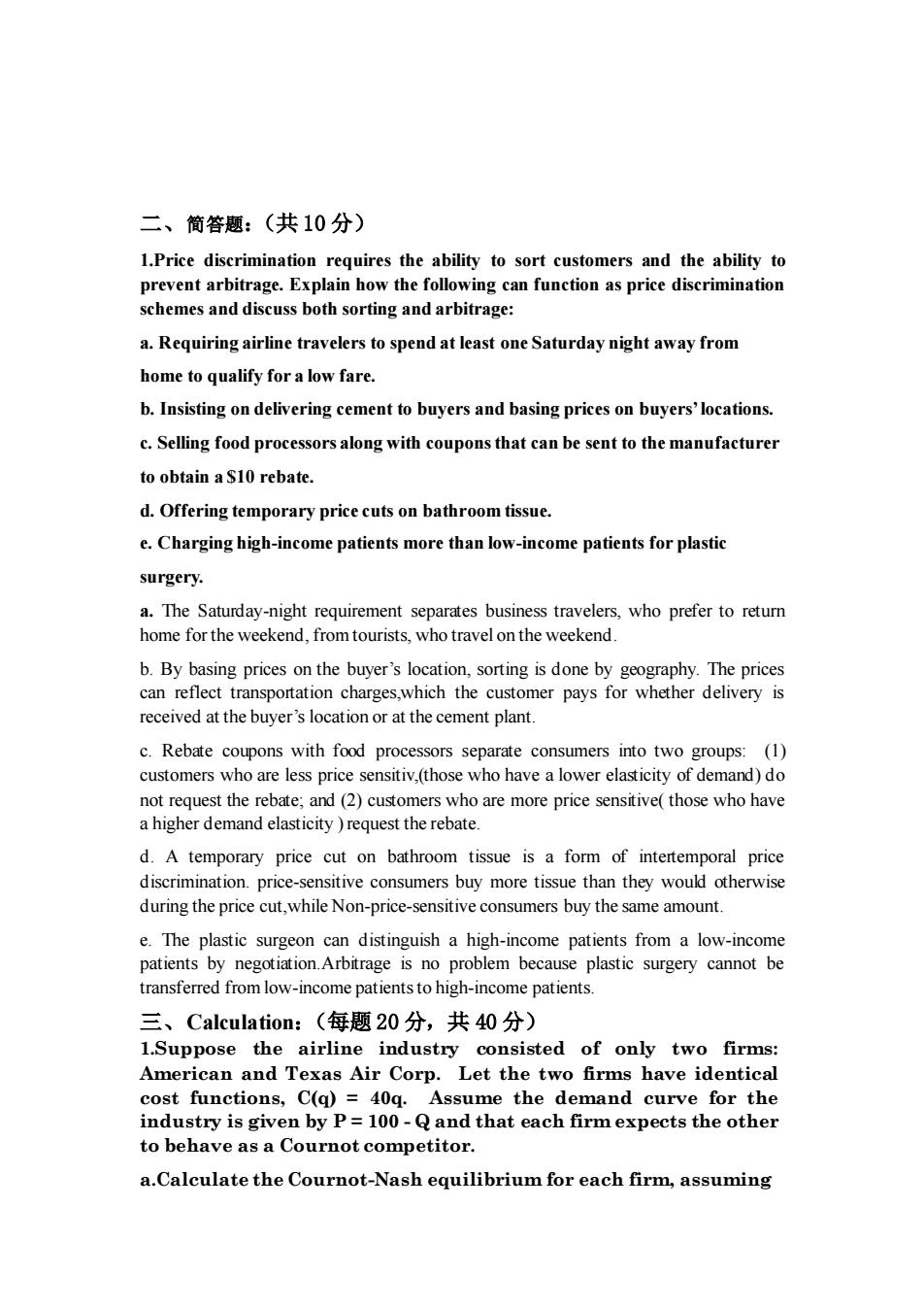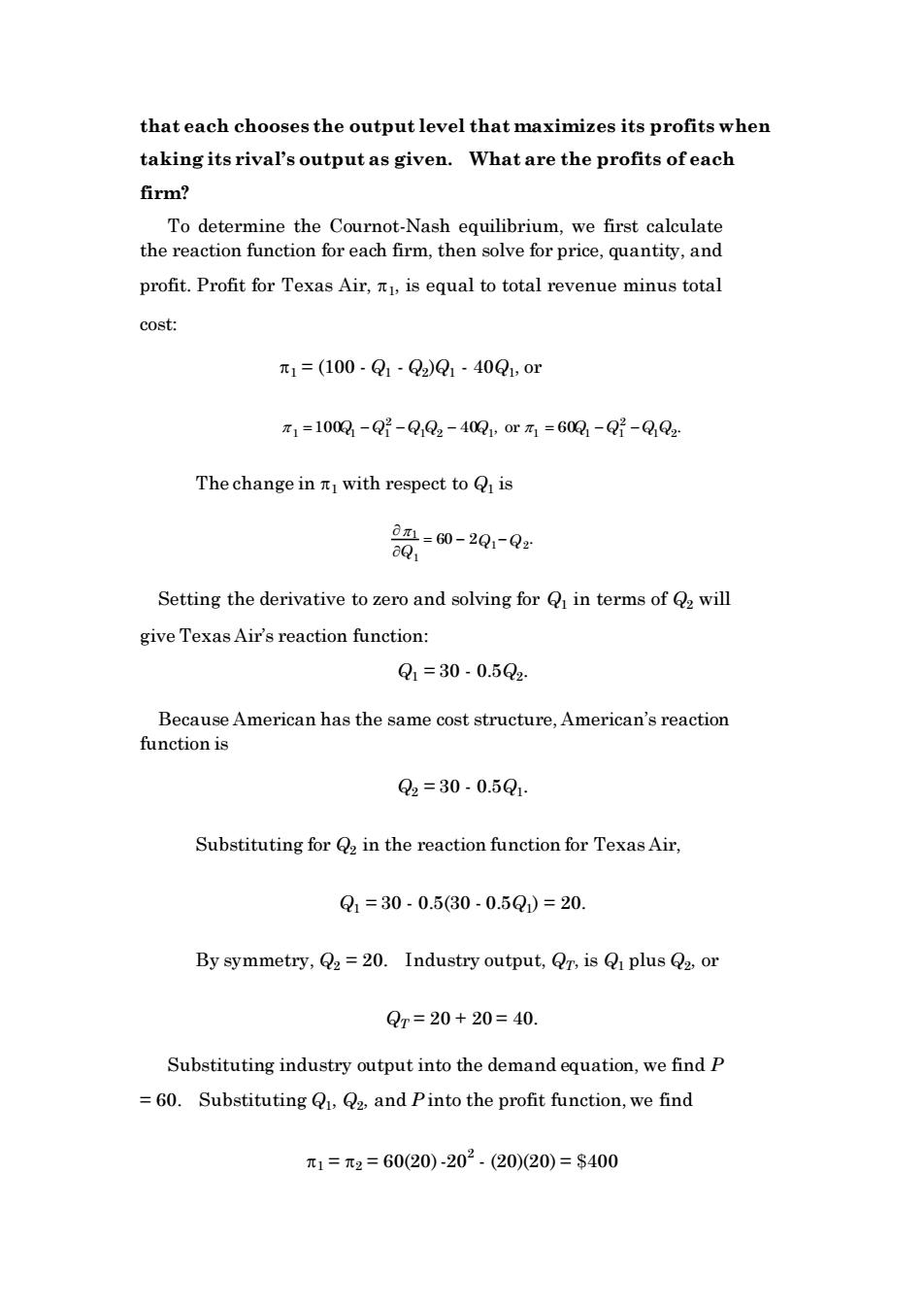
海南大学2007-08学年度第1学期《微观经济学》答案(A卷) 一、Please explain the following glossary::(每题5分,共50分) 1 Absolute advantage Situation in which country 1 has an advantage over country 2 in producing a go d because the cost of producing the good in 1 is lower than the cost of producing it in 2 2 Bertrand model Oligopoly model in which firms produce a homogeneous good. each firm treats the price of its competitors as fixed.and all firms decide simultaneously what price to charge 3 Coase theorem Principle that when parties can bargain without cost and to their mutual advantage,the resulting outcome will be efficient regardless of how property rights are specified. 4 Cobb-Douglas production function Production function of the formQ=AKL where Q is the rate of output,K is the quantity of capital,and L is the quantity of labor,and where a and b are constants. 5 Comparative advantage Situation in which country I has an advantage over country 2 in producing a good because the cost of producing the good in1.relative to the cost of producing other goods in 1,is lower than the cost of producing the good in 2,relative to the cost of producing other goods in 2. 6Completely inelastic demand Consumers will buy a fixed quantity of a good regardless of its price 7 Consumer surplus(individual)Difference between what a consumer is willing to pay for a good and the amount actually paid. r(aket)Nebn t onms purchaindEu er the demand curve above the price 8 Cooperative game Game in which participants can negotiate binding contracts that allow them to plan joint strategies. 9Coumot model Oligopoly model in which firms produce a hon ogeneous good each firm treats the output of its competitors as fixed,and all firms decide simultaneously how much to produce. 1Cro-ric Percentage change in the demandd of one good resulting from a I-percent increase in the price of another
海南大学 2007-08 学年度第 1 学期《微观经济学》答案(A 卷) 一、 Please explain the following glossary:(每题 5 分,共 50 分) 1 Absolute advantage Situation in which country 1 has an advantage over country 2 in producing a good because the cost of producing the good in 1 is lower than the cost of producing it in 2. 2 Bertrand model Oligopoly model in which firms produce a homogeneous good, each firm treats the price of its competitors as fixed, and all firms decide simultaneously what price to charge. 3 Coase theorem Principle that when parties can bargain without cost and to their mutual advantage, the resulting outcome will be efficient regardless of how property rights are specified. 4 Cobb-Douglas production function Production function of the form Q = AKaL b , where Q is the rate of output, K is the quantity of capital, and L is the quantity of labor, and where a and b are constants. 5 Comparative advantage Situation in which country 1 has an advantage over country 2 in producing a good because the cost of producing the good in 1, relative to the cost of producing other goods in 1, is lower than the cost of producing the good in 2, relative to the cost of producing other goods in 2. 6 Completely inelastic demand Consumers will buy a fixed quantity of a good regardless of its price. 7 Consumer surplus (individual) Difference between what a consumer is willing to pay for a good and the amount actually paid. Consumer surplus (market) Net benefit to all consumers purchasing a good. Equa1 to area under the demand curve above the price. 8 Cooperative game Game in which participants can negotiate binding contracts that allow them to plan joint strategies. 9 Coumot model Oligopoly mode1 in which firms produce a homogeneous good, each firm treats the output of its competitors as fixed, and all firms decide simultaneously how much to produce. 10 Cross-price elasticity of demand Percentage change in the quantity demanded of one good resulting from a 1-percent increase in the price of another

二、简答题:(共10分) 1.Price discrimination requires the ability to sort customers and the ability to prevent arbitrage.Explain how the following can function as price discrimination schemes and discuss both sorting and arbitrage: a.Requiring airline travelers to spend at least one Saturday night away from home to qualify for a low fare. b.Insisting on delivering cement to buyers and basing prices on buyers'locations. c.Selling food processors along with coupons that can be sent to the manufacturer to obtain a $10 rebate. d.Offering temporary price cuts on bathroom tissue. e.Charging high-income patients more than low-income patients for plastic surgery. a.The Saturday-night requirement separates business travelers,who prefer to return home for the weekend,from tourists,who travel on the weekend. b.By basing prices on the buyer's location sorting is done by geography The prices can t。 ich the custo mer pays for er delivery is c.Rebate coupons with food processors separate consumers into two groups:(1) customers who are less price sensitiv,(those who have a lower elasticity of demand)do not request the rebate:and (2)customers who are more price sensitive(those who have a higher demand elasticity)request the rebate. d.A temporary price cu on bathroom tissue is a form of interemporal price price- nsitive consumers buy more tissue than they woul otherwise during the price cut,while Non-price-sensitive consumers buy the same amount. e.The plastic surgeon can distinguish a high-income patients from a low-income patients by negotiation.Arbitrage is no problem because plastic surgery cannot be transferred from low-income patients to high-income patients. 三、Calculation:(每题20分,共40分) 1.Suppose the airline industry consisted of only two firms American and Texas Air Corp.Let the two firms have identical cost functions,C(q)=40q.Assume the demand curve for the industry is given by P=100-Q and that each firm expects the other to behave as a Cournot competitor. a.Calculate the Cournot-Nash equilibrium for each firm,assuming
二、简答题:(共 10 分) 1.Price discrimination requires the ability to sort customers and the ability to prevent arbitrage. Explain how the following can function as price discrimination schemes and discuss both sorting and arbitrage: a. Requiring airline travelers to spend at least one Saturday night away from home to qualify for a low fare. b. Insisting on delivering cement to buyers and basing prices on buyers’ locations. c. Selling food processors along with coupons that can be sent to the manufacturer to obtain a $10 rebate. d. Offering temporary price cuts on bathroom tissue. e. Charging high-income patients more than low-income patients for plastic surgery. a. The Saturday-night requirement separates business travelers, who prefer to return home for the weekend, from tourists, who travel on the weekend. b. By basing prices on the buyer’s location, sorting is done by geography. The prices can reflect transportation charges,which the customer pays for whether delivery is received at the buyer’s location or at the cement plant. c. Rebate coupons with food processors separate consumers into two groups: (1) customers who are less price sensitiv,(those who have a lower elasticity of demand) do not request the rebate; and (2) customers who are more price sensitive( those who have a higher demand elasticity ) request the rebate. d. A temporary price cut on bathroom tissue is a form of intertemporal price discrimination. price-sensitive consumers buy more tissue than they would otherwise during the price cut,while Non-price-sensitive consumers buy the same amount. e. The plastic surgeon can distinguish a high-income patients from a low-income patients by negotiation.Arbitrage is no problem because plastic surgery cannot be transferred from low-income patients to high-income patients. 三、Calculation:(每题 20 分,共 40 分) 1.Suppose the airline industry consisted of only two firms: American and Texas Air Corp. Let the two firms have identical cost functions, C(q) = 40q. Assume the demand curve for the industry is given by P = 100 - Q and that each firm expects the other to behave as a Cournot competitor. a.Calculate the Cournot-Nash equilibrium for each firm, assuming

that each chooses the output level that maximizes its profits when taking its rival's output as given.What are the profits of each firm? To determine the Cournot-Nash equilibrium,we first calculate the reaction function for each firm,then solve for price,quantity,and profit.Profit for Texas Air,is equal to total revenue minus total cost: 元1=(100.Q1-Q2)Q1·40Q1,or 元1=1009-Q-Q2-402,or元=60-Q-4Q2 The change in with respect to is 8-0-20-0 Setting the derivative to zero and solving for in terms of 2 will give Texas Air's reaction function: Q1=30-0.5Q2 Because American has the same cost structure,American's reaction function is Q2=30.0.5Q1. Substituting for Q2 in the reaction function for Texas Air, Q1=30.0.5(30.0.5Q1)=20. By symmetry,Q2=20.Industry output,r,is Q plus Q2,or 2r=20+20=40 Substituting industry output into the demand equation,we find P =60.Substituting Q1,Q2,and Pinto the profit function,we find 1=2=60(20)-202.(20)(20)=$400
that each chooses the output level that maximizes its profits when taking its rival’s output as given. What are the profits of each firm? To determine the Cournot-Nash equilibrium, we first calculate the reaction function for each firm, then solve for price, quantity, and profit. Profit for Texas Air, 1, is equal to total revenue minus total cost: 1 = (100 - Q1 - Q2)Q1 - 40Q1, or 1 1 1 2 1 2 1 1 1 1 2 1 2 =100Q −Q −Q Q − 40Q , or = 60Q −Q −Q Q . The change in 1 with respect to Q1 is = − − 1 1 1 2 60 2 Q Q Q . Setting the derivative to zero and solving for Q1 in terms of Q2 will give Texas Air’s reaction function: Q1 = 30 - 0.5Q2. Because American has the same cost structure, American’s reaction function is Q2 = 30 - 0.5Q1. Substituting for Q2 in the reaction function for Texas Air, Q1 = 30 - 0.5(30 - 0.5Q1) = 20. By symmetry, Q2 = 20. Industry output, QT, is Q1 plus Q2, or QT = 20 + 20 = 40. Substituting industry output into the demand equation, we find P = 60. Substituting Q1, Q2, and P into the profit function, we find 1 = 2 = 60(20) -202 - (20)(20) = $400

for both firms in Cournot-Nash equilibrium. b.What would be the equilibrium quantity if Texas Air had constant marginal and average costs of $25,and American had constan marginal and average costs of $40? By solving for the reaction functions under this new cost structure,we find that profit for Texas Air is equal to 元1=1008-Q-Q,Q2-25Q1=7521-Q-QQ2 The change in profit with respect to Q is aQ =75-2Q-Q2 Set the derivative to zero,and solving for in terms ofQ Q1=37.5.0.5Q. This is Texas Air's reaction function.Since American has the same cost structure as in 8.a.American's reaction function is the same as before: 22=30.0.5Q1 To determine substitute for Q in the reaction function for Texas Air and solve for Q: Q1=37.5-(0.5)30.0.5Q1)=30. Texas Air finds it profitable to increase output in response to a decline inits cost structure. To determine 2.substitute for Q in the reaction function for American: 02=30.(0.5)37.5.0.5Q2)=15. American has cut back slightly in its output in response to the increase inoutput by Texas Air
for both firms in Cournot-Nash equilibrium. b.What would be the equilibrium quantity if Texas Air had constant marginal and average costs of $25, and American had constant marginal and average costs of $40? By solving for the reaction functions under this new cost structure, we find that profit for Texas Air is equal to 1 1 1 2 1 2 1 1 1 2 1 2 =100Q −Q −Q Q − 25Q = 75Q −Q −Q Q . The change in profit with respect to Q1 is = − − 1 1 1 2 75 2 Q Q Q . Set the derivative to zero, and solving for Q1 in terms of Q2, Q1 = 37.5 - 0.5Q2. This is Texas Air’s reaction function. Since American has the same cost structure as in 8.a., American’s reaction function is the same as before: Q2 = 30 - 0.5Q1. To determine Q1, substitute for Q2 in the reaction function for Texas Air and solve for Q1: Q1 = 37.5 - (0.5)(30 - 0.5Q1) = 30. Texas Air finds it profitable to increase output in response to a decline in its cost structure. To determine Q2, substitute for Q1 in the reaction function for American: Q2 = 30 - (0.5)(37.5 - 0.5Q2) = 15. American has cut back slightly in its output in response to the increase in output by Texas Air

Total quantity,Qr,is Q1+Qz,or Qr=30+15=45 Compared to 8a,the equilibrium quantity has risen slightly. c.Assuming that both firms have the original cost function,C(q)=40q,how much should Texas Air be willing to invest to lower its marginal cost from$40 to $25,assuming that American will not follow suit? How much should American be willing to spend to reduce its marginal cost to S25,assuming that Texas Air will have marginal costs of $25 regardless of American's actions? Recall that profits for both firms were $400 under the original cost structure. With constant average and marginal costs of 25,Texas Air's profits will be (55)(30)-(25(30)=$900 The difference in profit is $500.Therefore,Texas Air should be willing to invest up to $500 to lower costs from 40 to 25 per unit (assuming American To determine how much American would be willing to spend to reduce its average costs,we must calculate the difference in profits,assuming Texas Air's average cost is 25.First,without investment,American's profits would be: (5515)-(4015)=$225 Second,with investment by both firms,the reaction functions would be: Q1=37.5-0.502and 02=37.5-0.501 To determine.substitute for in the first reaction function and solve for Q1=37.5-(0.537.5-0.5Q1)=25 Substituting for in the second reaction function to find 2 Q2=37.5-0.537.5-0.502)=25. Substituting industry outputinto the demandequationtodetermine price P=100-50=$50
Total quantity, QT, is Q1 + Q2, or QT = 30 + 15 = 45. Compared to 8a, the equilibrium quantity has risen slightly. c. Assuming that both firms have the original cost function, C(q) = 40q, how much should Texas Air be willing to invest to lower its marginal cost from $40 to $25, assuming that American will not follow suit? How much should American be willing to spend to reduce its marginal cost to $25, assuming that Texas Air will have marginal costs of $25 regardless of American’s actions? Recall that profits for both firms were $400 under the original cost structure. With constant average and marginal costs of 25, Texas Air’s profits will be (55)(30) - (25)(30) = $900. The difference in profit is $500. Therefore, Texas Air should be willing to invest up to $500 to lower costs from 40 to 25 per unit (assuming American does not follow suit). To determine how much American would be willing to spend to reduce its average costs, we must calculate the difference in profits, assuming Texas Air’s average cost is 25. First, without investment, American’s profits would be: (55)(15) - (40)(15) = $225. Second, with investment by both firms, the reaction functions would be: Q1 = 37.5 - 0.5Q2 and Q2 = 37.5 - 0.5Q1 . To determine Q1 , substitute for Q2 in the first reaction function and solve for Q1 : Q1 = 37.5 - (0.5)(37.5 - 0.5Q1 ) = 25. Substituting for Q1 in the second reaction function to find Q2 : Q2 = 37.5 - 0.5(37.5 - 0.5Q2 ) = 25. Substituting industry output into the demand equation to determine price: P = 100 - 50 = $50

Therefore,American's profits if =2=25 (when both firms have MC=AC=25) % π2=(100-25-25(25)-(25)25)=$625 The difference in profit with and without the cost-saving investment for American is $400.American would be willing to invest up to $400 to reduce its marginal cost to25 if Texas Air also has marginal costs of 25. eting firms are each plannin their choices at the same time.The resulting payoffs are shown below. We are given the following payoff matrix,which describes a product introduction game: Firm 2 A B C A -10-10 0.10 10.20 Firml B 10,0 -20.-20☐-5,15 20,10 15.-5-30,-30 a.Are there any Nash equilibria in pure strategies? If so,what are they? b.If both firms use maximin strategies,what outcome will result? c.If Firm 1 uses a maximin strategy and Firm 2 knows,what will Firm 2 do? a.Yes,there are two(1)Given Firm 2 chooses A,Firm 1 chooses C:given Firm 1 chooses C.Firm 2 chooses A.(2)Given Firm 2 chooses C,Firm 1 chooses A:given Firm 1 chooses A.Firm 2 chooses c. b.If both fi cho ccording to maximin,Firm 1 will choose Product A and Firm 2 will choose ProductA,resulting in-10 payoff for both c.Fimm 2 will choose Product C in order to maximize payoffs at 10,20
Therefore, American’s profits if Q1 = Q2 = 25 (when both firms have MC = AC = 25) are 2 = (100 - 25 - 25)(25) - (25)(25) = $625. The difference in profit with and without the cost-saving investment for American is $400. American would be willing to invest up to $400 to reduce its marginal cost to 25 if Texas Air also has marginal costs of 25. 2 Two competing firms are each planning to introduce a new product. Each will decide whether to produce Product A, Product B, or Product C. They will make their choices at the same time. The resulting payoffs are shown below. We are given the following payoff matrix, which describes a product introduction game: Firm 2 A B C A -10,-10 0,10 10,20 Firm 1 B 10,0 -20,-20 -5,15 C 20,10 15,-5 -30,-30 a. Are there any Nash equilibria in pure strategies? If so, what are they? b. If both firms use maximin strategies, what outcome will result? c. If Firm 1 uses a maximin strategy and Firm 2 knows, what will Firm 2 do? a. Yes, there are two(1)Given Firm 2 chooses A,Firm 1 chooses C;given Firm 1 chooses C,Firm 2 chooses A.(2)Given Firm 2 chooses C,Firm 1 chooses A;given Firm 1 chooses A,Firm 2 chooses c. b. If both firms choose according to maximin,Firm 1 will choose Product A and Firm 2 will choose Product A,resulting in -10 payoff for both. c. Firm 2 will choose Product C in order to maximize payoffs at 10,20